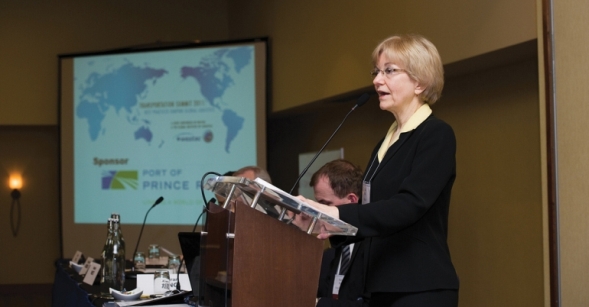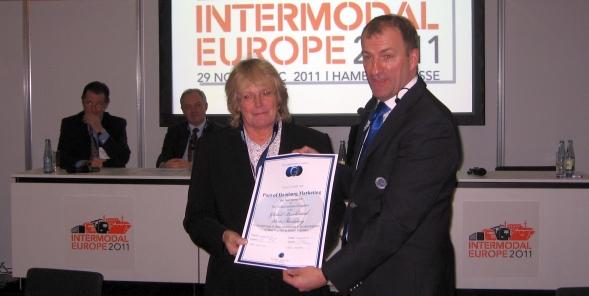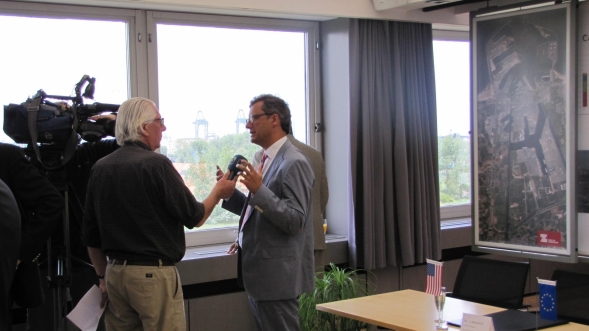2011
2011_westac_vancouver
VANCOUVER MAY 2011
TRANSPORTATION SUMMIT 2011 BEST PRACTICES SHAPING GLOBAL LOGISTICS
Melissa Edwards Canadian Sailings
Mr. Ring is CEO of the Global Institute of Logistics (GIL), a U.S.-based not-for-profit supply chain research group, which partnered with Canada’s Western Transportation Advisory Council (WESTAC) to hold the conference in Vancouver. “If you are a well-paid soloist, being asked to join an orchestra is a big move,” Mr. Ring said. “Everyone in their silo is doing a great job. But the value gets trapped in the handover.” Mr. Ring said point-to-point thinking and a system built on an old-fashioned “legacy” model has resulted in 8.9 cents out of every dollar being spent on logistics in the U.S. In China, where the cost is as high as 20 cents, a new five-year plan is in place to get the cost below the U.S. figure.

“When resources are limited, let’s not reinvent things. We can find a better way with the best of what others already know.”
“We can get our cost down by half if we remove the silos,” Mr. Ring said. He told the crowd that the only question left in the move toward orchestration is: Who will act as bandleader? Mr. Ring’s organization is in the final stages of a four-year research project on best practices in global logistics.
WESTAC president Ruth Sol told Canadian Sailings that the idea for the summit arose after her team met with GIL in October. “They just blew us away. They had so much information,” she said. “When resources are limited, let’s not reinvent things. We can find a better way with the best of what others already know.”
GIL began its research process by forming global committees for each silo (shippers, logistics professionals, port authorities, terminals, shipping lines, information technicians, warehouses, distributors and customers), as well as regional cross-silo chapters with links to government, academics and service providers. Mr. Ring said GIL set out with the idea that terminal operators might be well placed to take a leadership role in a collaborative system, so it undertook a three-year study of terminal hubs such as Yantian in China.
The research culminated in the creation of GIL’s Container Terminal Quality Indicator (CTQI) trademark. GIL examined factors such as gross moves per hour, equipment age, truck calls, throughput and other metrics, and created benchmark figures against which terminal quality can be improved. Those who meet the benchmarks can earn CTQI status.
Mr. Ring hopes that GIL can expand this benchmarking process to other parts of the supply chain. “Everyone who touches (the container) should have a quality indicator,” he said. While the benchmarking process made the research worthwhile, the lack of transparency inside the gates of the terminal meant the operators were not “the white knights” GIL had set out to find, Mr. Ring said. “But then we found the port authority. The new generation (of port authority) is moving beyond being landlords to become economic strategists. They’re not competing, because the collective performance of their stakeholders leads to better performance for the port.
ABOUT WESTAC
The Western Transportation Advisory Council (WESTAC) is a non-profit association dedicated to advancing Western Canada’s economy through excellence in transportation. Founded in 1973 by four western provincial transport ministers, the Council is a well-respected, powerful and balanced forum of major organizations. Member organizations span the modes and sectors and include service providers, labour unions, shippers, policy-makers and regulators.
WESTAC’s vision is to be the prime catalyst for supply chain excellence. The Council promotes transportation as a critical sector supporting trade, jobs and our high standard of living, and advances solutions to transportation problems across sectors. As one of Canada’s premier transportation organizations and a trusted industry champion, WESTAC ensures that transportation retains its vital status in the community.
WESTAC Homepage
2011: Global Benchmark in Port Marketing
HAMBURG NOVEMBER 2011
HAMBURG PORT MARKETING: GLOBAL BEST-IN-CLASS PORT MARKETING AGENCY
Globally “First Mover” Port Authorities and their communities have devised and developed a myriad of strategies and programs designed to deliver a seamless integrated logistics product to their customers. The Institute established direct relationship with many of them as part of its “The Role of the Container Port in Global Logistics” research. Our aim was to identify strategies that saw port community stakeholders engaged in a collaborative process. Port Community stakeholders like most businesses were found to be primarily interested in business development and when properly informed convinced of the merits of cooperating with their competitors in their pursuit of developing the overall market share enjoyed by their homeport.

Claudia Roller CEO Hamburg Port Marketing Receives the Formal Certification from Kieran Ring CEO Global Institute of Logistics at Intermodal Europe
The use of marketing as a business development strategy proved to be particularly effective in building the port community at the port of Hamburg. Port of Hamburg Marketing (HHM) was founded in 1985 by Hamburg-based port-related companies including terminal operators and forwarding and logistics companies, as a non-profit organisation offering marketing and market research information for its members. Since then it has grown to a worldwide network, including 24 staff in Hamburg and 39 in its 12 representative offices, promoting the business location of the Port of Hamburg and its greater metropolitan area. Although member companies are competitors, they are represented jointly by the agency which acts as an umbrella brand uniting its members and creating a “spirit” of collaboration.
Members of HHM are constantly linked with one another and with HHM staff, and supplied with detailed data, facts and background briefings on the latest developments in the port and transport sectors and in addition to up-to-date statistics on sea transport, foreign trade and transit services. Members also benefit from the agencies PR activities, which gives the Port of Hamburg a presence worldwide, this is combined with representation at trade fairs, information evenings and customer events around the world.
The combined effect of all of these activities is very positive, the Port of Hamburg is a river port and does not enjoy unfettered access to the coast like its competitors in Europe. As a result it needs to stay one step ahead of the game to survive and thrive.
As cargo owners became less concerned about port to port execution and focus on point of production to point of consumption in the engineering of their supply chains, access to the Hamburg port community through a single agency is particularly attractive.
Today Hamburg Port Marketing has developed to far more than a marketing and promotional agency, it is increasingly liaising with cargo owners on behalf of its members and the port to design the fastest flowing and reliable logistics process.
It is the Benchmark in global port marketing.
2011: Joachim Coens Appointed GIL Chairman
ANTWERP MARCH 2011
JOACHIM COENS APPOINTED CHAIRMAN OF GIL
With globalisation and the evolution of shipping as vessels of bigger dimensions arrive on the scene, port authorities need to do more than just be landlords focusing on building infrastructure, providing cranes and improving market access to be more competitive, said Joachim Coens, chairman and managing director of the Port of Zeebrugge in Belgium. Speaking to media on the occasion of his appointment as Chairman of the European chapter of the Global Institute of Logistics, Coens said:

AS CHAIRMAN OF THE GLOBAL INSTITUTE OF LOGISTICS
click on picture to hear interview
“Ports need to have a dialogue. Not only with shipping lines and other ports but also with manufacturers, exporters and importers, stevedores, and logistics and transport companies to help them make the flow of goods more cost-effective and efficient.” “They must sit in the midst of the logistics stream of goods moving across the hinterland and going from Europe to South China and the rest of Asia and vice-versa,” he added.
Port Authorities don’t have to go it alone, Coens said. They can pool their expertise and resources with transport companies, terminal operators and stevedores and share the costs and profits for developing a more efficient service. Coens called on ports and institutions like the Global Institute of Logistics to connect with ports in China, Africa and the US and see what are the moods. “It is not the same everywhere. Some have good river connections, some rail connections. Everybody must know what’s important for them. So the ports need to change and see how they can help each other,” he said. Coens said ports needed to be actively involved in the cargo scene, talking to shipping lines, hinterland connections, customers, veterinary control authorities, Customs as well as government officials to ease trade barriers.
In this context, the Port of Zeebrugge has set up a company called PortConnect whose job is to see where the cargo is coming from and where it is getting to, and see how it can play a role in the middle. PortConnect includes APM Terminals Zeebrugge, PSA Zeebrugge, Inter Ferry Boats and Naviland Cargo. The last two provide the rail service.
“We can suggest to our customers the best way to send their goods. We have people in Europe who export but probably not in the most efficient way,” said Coens. “For example, we detected that deep freeze products went to Italy by truck one by one, customer by customer. We suggested to our customers to consolidate all those shipments at the port and put it on the train, which would be more cost-efficient. Now most of that cargo goes by rail three times a week.”
“So it is not only knowing where the market is but the best way to reach that market, which many customers are not aware of,” he added.
Traditionally, hinterland logistics has been out of the Port of Zeebrugge’s hands. It is the state-owned railways or the private inland navigation barges or the truck companies that handle this. Whenever the cargo needs to be picked up they do it and the port authorities do not play a role. That’s not their business. But that has changed because the operation is becoming so complex and with the huge volumes involved, the ports have had to get more involved.
Another initiative of PortConnect was the setting up of a regular container rail shuttle between the Port of Zeebrugge and the city of Dourges in Northern France. PortConnect found that the best way to operate in the French market all the way to Italy and Spain was the rail connection from the north of France. “So we went to the rail operators, put them together with our terminal operators and shipping lines and together we drew up a plan,” said Coens.

